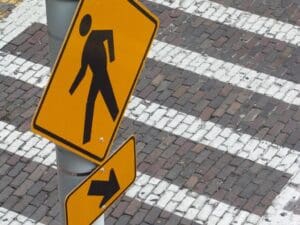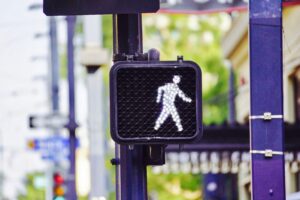Do Pedestrians Always Have the Right of Way?
When you first learned to drive, you may have been told pedestrians have the right of way. While this is generally true, pedestrians don’t always have the right of way. Of course, drivers must always be aware of their surroundings, including looking for pedestrians, but pedestrians must also be aware of traffic lights, crosswalks, and oncoming traffic.
If you were involved in a pedestrian accident and are questioning who has the right of way, Munley Law is here to help.
When Do Pedestrians Have the Right of Way?
Under Pennsylvania law, there are a few scenarios where pedestrians always have the right of way. However, it is ultimately the responsibility of drivers and pedestrians to practice safety on the roadways and be mindful before walking into traffic.
Crosswalks Without Signals

Because of this, pedestrians must exercise caution and not walk or run unexpectedly into the path of traffic. Be mindful to look both ways before you cross the street, and do not assume a driver will yield to you. If there are no crosswalk signs but there are traffic lights, be sure to obey the red, yellow, or green light to determine if it is safe to cross.
Crosswalks with Signals
Pedestrians at marked crosswalks with signals do have the right of way when the signals are flashing walk. However, if the signal is flashing don’t walk, pedestrians must obey these signs.
Further, if the crosswalk signal has a raised hand flashing and says don’t walk, you must either finish crossing the street if you have already begun or do not start walking if you have not yet left the curb.
Drivers must be mindful of pedestrian crossing signals. Pedestrians don’t always obey these signals, which could lead to an accident if the driver is not cautious.
Pedestrian Right of Way in School Zones
In several situations in school zones, pedestrians have the right of way.
The first is at marked or unmarked intersections and crosswalks. Typically, traffic control devices monitor driver speed to ensure drivers stay at the school zone speed, which is 15 mph in Pennsylvania.
School zones may also have mid-block crosswalks to keep traffic moving and keep pedestrians safe. Mid-block crosswalks are common in busy streets with heavy pedestrian traffic.
Drivers in school zones must also yield the right of way to pedestrians when approaching sidewalks that cross a driveway, alley, building, or road.
Lastly, pedestrians have the right of way at school bus stops, as the bus arm will alert drivers from behind and approaching to stop so students can safely exit the bus and walk to their destination.
Responsibilities of Drivers Toward Pedestrians
Pedestrian safety laws are meant to protect vulnerable road users and keep motor vehicle drivers safe while sharing the road. However, given the size of a car or truck compared to a pedestrian, we expect drivers to uphold certain responsibilities.

Further, do not engage in distracted driving, as moving into a busy intersection can quickly turn fatal if you do not see a pedestrian crossing the street. But pedestrians must also be alert, and consider wearing reflective clothing to ensure drivers can see you.
If you encounter a blind pedestrian using a white cane or accompanied by a guide dog, drivers should yield the right of way to the pedestrian. However, pedestrian laws protect blind or partially blind pedestrians who do not use a cane or guide animal from falling under contributory negligence should they be involved in an accident. Knowing this, drivers must consider all traffic laws and be mindful of individuals approaching a marked or unmarked pedestrian crosswalk.
Exceptions to Pedestrian Right of Way

- Crossing outside an intersection or crosswalk, specifically if it is unmarked. While drivers should yield if the pedestrian is already crossing, pedestrians cannot cross into oncoming traffic.
- Pedestrians must also not jaywalk, as this is considered a negligent or reckless act that can make them liable in a pedestrian accident. In Pennsylvania, jaywalking is illegal; motorists should be mindful of pedestrians who try crossing streets illegally to protect themselves from a car accident.
- Pedestrians cannot walk on roadways like highways or freeways, as this is not a safe environment for vulnerable road users.
- Pedestrians must also obey traffic signals and cannot obstruct the flow of traffic by crossing in the middle of the road, waiting, or crossing when it is unsafe. If a pedestrian crossing into an oncoming vehicle has not exercised their duty of care to cross the road safely, they may have limited options for financial recovery.
- If a pedestrian knows they are obscured from view by drivers, they should not cross.
- Pedestrians should not cross a railroad by going through, around, over, or under a closed or opening railroad gate or barrier.
If a pedestrian is found to be negligent in their actions, it can impact their compensation.
The Impact of Right of Way on Pedestrian Accident Claims
Pedestrian crashes can be complicated because of right-of-way discrepancies. Under Pennsylvania highway codes, drivers must practice safe driving and be mindful of pedestrians and other road users.
But if the pedestrian did not have the right of way and crossed the street anyway, this can impact their legal claim.
Pennsylvania follows the comparative negligence rule for personal injury cases. Under the rule, your compensation is adjusted by the percentage of fault you hold. For example, if a pedestrian crossed when they did not have the right of way, they may not have a successful claim if it is found that the accident would not have occurred had they not crossed. But, if the driver was also driving recklessly and carried more than 50 percent of the fault for the accident, the pedestrian may still recover compensation.
Determining liability in a pedestrian accident case can be complicated, work with a personal injury attorney from Munley Law to ensure your rights are protected.
Have You Been Injured in a Pedestrian Accident?
If you or a loved one have been hurt in a pedestrian accident, Munley Law is here for you. Our pedestrian accident attorneys can help manage the legal process while you recover from your severe injuries.
As a vulnerable road user, pedestrian safety must be taken seriously. If you were injured by a motor vehicle as a pedestrian, you have options. Call Munley Law today for a no-obligation free consultation, or connect with us online by filling out our contact form to learn your legal rights.

Marion Munley
Marion Munley is recognized for her compassionate representation of catastrophically injured clients and her steadfast dedication to them and their families. Her advocacy has produced numerous multimillion-dollar recoveries, including one of the largest trucking accident settlements on record. Marion is Triple Board Certified by the National Board of Trial Advocacy in Civil Trial, Civil Practice, and Truck Law, and since 2023 has been named one of Pennsylvania’s Top 10 Super Lawyers by Super Lawyers.
Posted in Personal Injury.
Tagged Claim Distracted Driving Duty of Care Fault Liability Negligence









